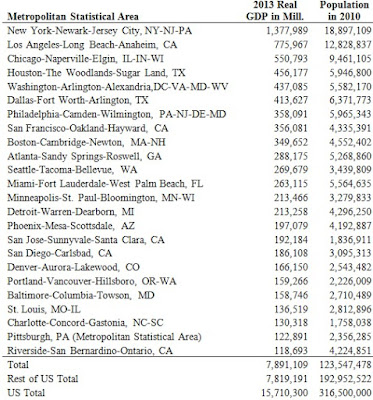A recent article on MarketWatch showed a map which pointed out that half the GDP of USA is concentrated in a few cities only. On first thought, it seems about right because most of the US is sparsely populated (think about the western states). I thought I should do a little more analysis to see how much this holds. I collected real GDP (chained 2009 dollars) of some of the largest metropolitan statistical areas (MSAs) of the US from the website of the Bureau of Economic Analysis (www.bea.gov). I also collected the population data of those MSAs from the Census Bureau. The data is tabulated below:
These 24 MSAs do indeed produce half the GDP of the US. If you look the population, these 24 MSAs together house about 123.5 million individuals in 2010. Thus about 40 percent of the population of the US do live in these 24 MSAs. Another way of looking is that 50 percent of the GDP of US is produced in these 24 MSAs, where 40 percent of the US population resides.
If we look at per capita GDP of these 24 MSAs, we can find that each inhabitant of these MSAs have a GDP per capita of about $66,000. The rest of the US has a GDP per capita of around $40,000 (the US average is around $50,000 in chained 2009 dollars). Thus, these 24 MSAs have a GDP per capita that's about $24,000 more than the GDP per capita of the rest of the country. This shows that the largest MSAs in the US are considerably richer in GDP per capita terms than the rest of the country. There can be a lot of reasons why this is so. There is considerable positive spillovers (more businesses opening, people learning skills from each other) that can accumulate in an area that has high population density. So, that can explain why the largest cities also have high GDP per capita.
However, this does not imply that the status quo should be maintained. To promote a more equitable growth, the governments, both federal and state, should promote growth in the smaller MSAs. Increasing business activities in the smaller MSAs could help to bridge the the income gap we see from this table. It can also promote a more balanced growth across the country, and make the county considerably richer.

No comments:
Post a Comment